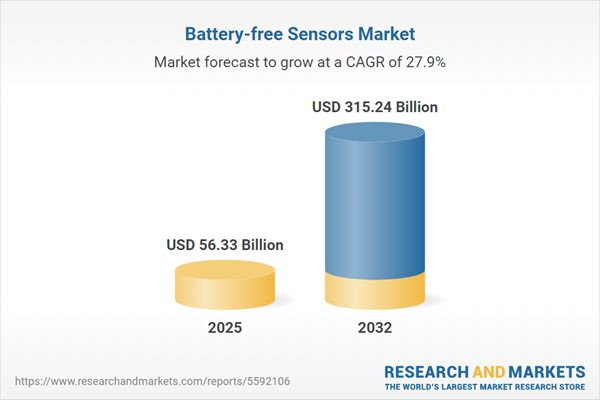Speak directly to the analyst to clarify any post sales queries you may have.
Battery-free sensors are redefining enterprise asset monitoring, equipping organizations to capture operational data in real time and respond adaptively to change. Enterprises facing regulatory complexity and infrastructure modernization are rapidly adopting battery-free sensors to upgrade resilience and efficiency across sectors.
Market Snapshot: Battery-Free Sensors Market Growth Outlook
The global battery-free sensors market reached USD 44.02 billion in 2024 and is projected to grow to USD 56.33 billion in 2025, reflecting a compound annual growth rate of 27.90%. Widespread adoption is driven by increased investment in energy harvesting technologies and a mounting enterprise demand for reliable, continuous data capture in operational environments. Companies are using battery-free sensors to modernize monitoring, ensure data-driven efficiency gains, and support evolving compliance mandates. These enterprise-ready systems are experiencing rapid deployment in key industries, including manufacturing, logistics, agriculture, and healthcare, as market players align with changing technology requirements and sector-specific regulations.
Scope & Segmentation of the Battery-Free Sensors Market
The battery-free sensors market addresses a comprehensive set of challenges faced by modern enterprises, spanning digital transformation, operational optimization, and regulatory adherence. Strategic segmentation provides leaders with actionable insights for maximizing returns through technology innovation and targeted partnerships. Key segmentation categories include:
- Application Areas: Enable logistics tracking, predictive fleet maintenance, precision agriculture decision-making, advanced manufacturing oversight, aerospace and defense monitoring, as well as retail and healthcare process enhancement.
- Energy Harvesting Approaches: Utilize electromagnetic, radio frequency, solar, thermal, and vibration-based methods for sensor operation, supporting deployment in areas with limited access to conventional energy sources.
- Communication Technology: Integrate Bluetooth Low Energy, NFC, RFID, ultra wideband, and Wi-Fi to ensure secure and adaptable onsite and remote data transmission across organizational sites.
- Sensor Types: Leverage accelerometers, pressure, humidity, proximity, motion, and temperature sensors for data precision and tailored analytics addressing sector-specific safety and monitoring needs.
- End Users: Meet specialized compliance and operational expectations across agriculture, automotive, consumer goods, defense, manufacturing, retail, and healthcare sectors.
- Regions: Assess adoption rates and regulatory context in the Americas, Europe, Middle East, Africa, and Asia-Pacific to inform targeted expansion, mindful of infrastructure and policy differences across global markets.
- Leading Companies: Observe technology advantages and market leadership by EnOcean GmbH, Texas Instruments, STMicroelectronics N.V., NXP Semiconductors N.V., Analog Devices, Infineon Technologies AG, ON Semiconductor, Microchip Technology, Murata Manufacturing, and Powercast Corporation, providing insight into industry collaboration and competitive benchmarks.
Key Takeaways for Senior Decision-Makers
- Battery-free sensors support uninterrupted monitoring even in locations with limited or unstable power access, strengthening solutions for asset visibility and enterprise risk management.
- Deployment of advanced energy harvesting technologies allows organizations to reduce maintenance requirements and expand monitoring coverage while supporting sustainability objectives and compliance efforts.
- Flexible, modular integration strategies enhance resilience, enabling adaptive supply chain management and operational responsiveness to evolving regulations.
- Robust communication protocols and energy harvesting options assure reliability in data transfer under varying operational demands, securing compliance and process continuity.
- Compatibility with legacy infrastructure preserves prior investments while allowing organizations to scale monitoring solutions in line with future operational and compliance requirements.
- Tailored deployment strategies, sensitive to regional regulatory frameworks and workforce needs, facilitate effective scaling and measurable operational success across diverse markets.
Tariff Impact: Navigating the Shifting Global Landscape
Recent changes in United States tariff policy are prompting technology providers to reevaluate their supply chain approaches for battery-free sensors. With manufacturing progressively relocating to Asia-Pacific and Middle Eastern markets, companies are leveraging accessible regulatory frameworks and enabling resilient supplier networks. This strategic shift is supporting enterprise goals around supply chain stability and adherence to diverse international trade requirements.
Methodology & Data Sources
This analysis is based on expert interviews, in-depth supply chain evaluations, scenario-driven forecasts, and sustained monitoring of global regulatory and intellectual property developments. These methodologies offer a robust foundation for executive-level decision making and strategic risk assessments in the battery-free sensors market.
Why This Report Matters
- Aligns sensor investment strategies with digital transformation and organizational sustainability priorities, strengthening resilience against operational uncertainty.
- Helps identify optimal technology partners and network structures that address today’s and tomorrow’s challenges in evolving enterprise markets.
- Provides actionable direction for achieving compliance and operational scalability within demanding and diverse environments.
Conclusion
Battery-free sensors empower organizations to achieve agile, stable monitoring and rapid operational response. Senior leaders can use this analysis to inform robust strategies and ensure enterprise readiness for ongoing technological and regulatory changes.
Additional Product Information:
- Purchase of this report includes 1 year online access with quarterly updates.
- This report can be updated on request. Please contact our Customer Experience team using the Ask a Question widget on our website.
Table of Contents
3. Executive Summary
4. Market Overview
7. Cumulative Impact of Artificial Intelligence 2025
Companies Mentioned
The companies profiled in this Battery-free Sensors market report include:- EnOcean GmbH
- Texas Instruments Incorporated
- STMicroelectronics N.V.
- NXP Semiconductors N.V.
- Analog Devices, Inc.
- Infineon Technologies AG
- ON Semiconductor Corporation
- Microchip Technology Incorporated
- Murata Manufacturing Co., Ltd.
- Powercast Corporation
Table Information
| Report Attribute | Details |
|---|---|
| No. of Pages | 199 |
| Published | November 2025 |
| Forecast Period | 2025 - 2032 |
| Estimated Market Value ( USD | $ 56.33 Billion |
| Forecasted Market Value ( USD | $ 315.24 Billion |
| Compound Annual Growth Rate | 27.9% |
| Regions Covered | Global |
| No. of Companies Mentioned | 11 |









